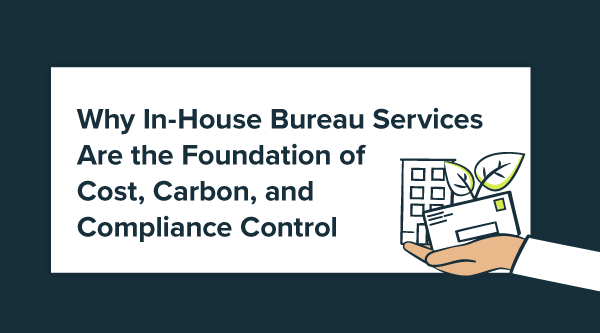Six Reasons to Replace your Spreadsheets with an Energy Management Information System (EMIS)
Question: What is the presumptive first step in establishing an energy management or sustainability program?
Answer: Create a spreadsheet to track, analyze, and report on your data.
For decades, spreadsheets have been the de facto starting point for utility bill tracking, energy management, and sustainability analysis and reporting. And there are very legitimate reasons for that. Everyone has access to spreadsheets, so there’s no need to go through a potentially time-consuming application search, evaluation, and procurement process. Most of us have at least basic spreadsheet creation and management skills, and training resources are readily available at low or no cost. Spreadsheets are also powerful, able to perform complex analyses and generate informative, attractive reports. And it’s because of these traits, and some others, that you should not rely on spreadsheets as the foundation of your energy management program.
As promised, here are six reasons why you should replace your spreadsheets with an energy management information system (EMIS). Or if you’re just starting out, here’s why you should skip that presumptive first step:
- Costly errors. Numerous studies and personal experience have shown that a high percentage of spreadsheets contain errors: logic or reference mistakes, data entry errors, missing data. Mistyping, adding, or omitting a single digit can produce significant negative consequences that impact critical decisions or result in late fees or shutoff notices. When performance contracts are involved, inaccurate data can cost an organization thousands of dollars. The more complex the spreadsheet, the more difficult it is to identify data errors.
- Complexity. For a spreadsheet to provide a high level of energy management value, it must be complex. Why? Because energy management is complex. Understanding complicated rate structures, accounting for renewable purchases and on-site generation, normalizing for weather and other factors, analyzing interval data and load profiles, it’s a lot. And it’s not getting easier.
- Single Point of Failure. Your Excel expert invests hundreds of hours assembling a macro-enabled, formula-dense spreadsheet. It works just the way you want it, with only a few tweaks required each month. And then the expert retires or moves to a different department. Now what? Your analysis and reporting capabilities are tied to a spreadsheet that you don’t know how to maintain.
- Lack of Security. Data security is a top-of-mind concern. Unfortunately, the spreadsheet that contains your utility account data, addresses, and, potentially, employee contact information is susceptible to hacking and data corruption. Who’s responsible for backing up the mission-critical data? How many times has the spreadsheet been shared as an email attachment? What’s the level of effort required to start over again if the spreadsheet’s functionality is compromised or data is lost?
- Limited audit trail. Energy management information systems (EMIS) typically maintain historical data so you can track the history of utility accounts, energy projects, facility changes, etc. When changes are made, EMIS also record who made the changes, when, and why. Detailed histories and audit trails are not common spreadsheet features.
- Lack of features. Spreadsheets are much like all-season tires: designed to work well under a variety of conditions but not great in any one of them. Flexibility makes is possible to create a functional energy management spreadsheet, but it will never match the feature set of an application designed specifically for comprehensive utility bill accounting and energy management. Attempting to develop your own EMIS via a spreadsheet is akin to reinventing the wheel, albeit a far less functional version of it.
Countering the disadvantages of energy-management-by-spreadsheet are multiple advantages of implementing an EMIS:
- Data entry & accuracy. Entering utility bill data into a spreadsheet is usually a time-consuming manual process that is prone to errors. Most EMIS offer the ability to import data in workable flat file formats in addition to providing technology enabled utility bill processing services, saving time and greatly increasing data accuracy. A good EMIS will also offer automated data auditing functionality to alert the user to potential data quality issues.
- Calculations. Tens or hundreds of thousands of hours of skilled labor are required to develop a functional, high-quality EMIS. It’s just not realistic or practical to think that your organization will make that level of investment to recreate that functionality in a spreadsheet. And if you try, the formulas will be quickly become extremely complex and very difficult to maintain.
- Automation & integration. EMIS are designed to make life easier for energy and sustainability managers, and they do that in large part by automating and streamlining processes. Spreadsheet users commonly spend days or weeks compiling data just to produce a few monthly reports that they hope are accurate. Counter that with an EMIS-based process that virtually eliminates manual data entry, automatically audits utility bill data, shares approved billing data with an accounting system, and instantly presents informative actionable data via dashboards and reports that are accessible organization-wide.
- Maintenance & upgrades. Do you always have the benefit of using the most recent version of your spreadsheet application? Most likely, you receive upgrades when they’re implemented by your organization’s IT staff. Most EMIS are vendor-hosted SaaS applications, meaning that you receive upgrades upon release and, therefore, always have access to the latest, greatest functionality. No need to wait on your over-loaded IT team.
- Support & training. When your complex, custom-built spreadsheet fails to function properly, who do you contact for assistance? Who is responsible for training new employees to use the spreadsheet that you created and maintain? A subscription to a commercial-off-the-shelf (COTS) energy management application most likely includes access to online support resources and a team of experts who are available to answer your questions, troubleshoot technical issues, and train new employees.
- Data security & accessibility. With cloud-based energy management systems, the data is hosted by the EMIS vendor. You should expect that, in addition to hosting your live database in a secure environment, the vendor maintains backup copies that can be restored quickly, if needed. Ask potential EMIS vendors about their hosting environment and if they offer multiple levels of service. (E.g., Federal agencies most likely require that their data resides in a FedRAMP-authorized environment.) The cloud environment also makes it possible for data to be accessed from anywhere at any time, an ideal scenario for users who are working away from the office.
Spreadsheets vs. Energy Management Information System
| Spreadsheets | EMIS |
| Data entry & accuracy | Staff spends hours manually entering or importing data; errors are common and often difficult to find | Data can be imported from other systems, eliminating manual data entry; checked automatically for accuracy |
| Calculations | Formulas become complex quickly; maintaining them is challenging, and changes are usually not recorded | Custom process and calculations are documented; only authorized personnel can make changes, and changes are time/date stamped |
| Automation & integration | Most processes are initiated manually; integration with other systems is limited, at best | Commonly integrated with asset management, accounting, and metering systems to ensure access to comprehensive, current data |
| Security | Accessible by multiple staff members and easy to share externally via email and other means | Access controlled by assigned, individual user rights; access is recorded, and changes are logged automatically |
| Maintenance & support | Version control via organization’s IT department; support limited to in-house knowledge pool | Vendor provides online support resources and experts who are available to answer your questions, troubleshoot technical issues, and provide training |
| Accessibility | Access is limited to reduce opportunity for data corruption or security breach | Vendor hosts data in a secure environment; accessible from anywhere by authorized team members with managed read/revise rights |
Everyone recognizes the value and convenience of spreadsheets. The availability, flexibility, and powerful functionality make them invaluable tools. That said, spreadsheets are not the ideal solution for every need. Comprehensive energy management and sustainability programs warrant investment in a tool designed for their unique and complex data tracking, analysis, and reporting needs.
If you’re looking to upgrade from a spreadsheet-based program or are building the foundation of an energy conservation program, start your research with our field guide, “How to Spec and Purchase and Energy Management Information System (EMIS).”
Best-in-class portfolio-level energy and utility bill data management and reporting.
Real-time energy and sustainability analytics for high-performance, net-zero buildings.
A holistic view of financial-grade scope 1, 2, and 3 carbon emissions data across your entire business.
Energy and sustainability benchmarking compliance software designed for utilities.






